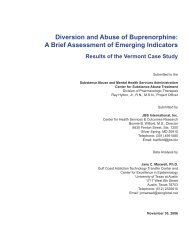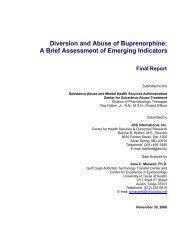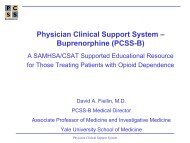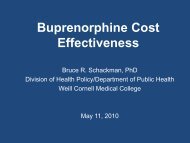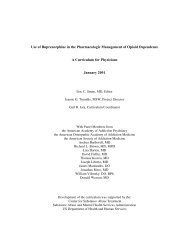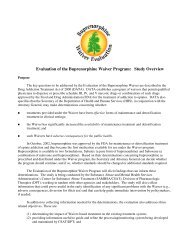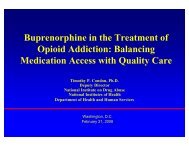Subutex Discontinued - Buprenorphine
Subutex Discontinued - Buprenorphine
Subutex Discontinued - Buprenorphine
You also want an ePaper? Increase the reach of your titles
YUMPU automatically turns print PDFs into web optimized ePapers that Google loves.
SUBOXONE (CIII)<br />
(buprenorphine HCl and naloxone HCl dihydrate sublingual tablets)<br />
SUBUTEX (CIII)<br />
(buprenorphine HCl sublingual tablets)<br />
Rx only<br />
Under the Drug Addiction Treatment Act of 2000 (DATA) codified at 21 U.S.C. 823(g), prescription use of<br />
this product in the treatment of opioid dependence is limited to physicians who meet certain qualifying<br />
requirements, and have notified the Secretary of Health and Human Services (HHS) of their intent to prescribe<br />
this product for the treatment of opioid dependence.<br />
DESCRIPTION<br />
SUBOXONE sublingual tablets contain buprenorphine HCl and naloxone HCl dihydrate at a ratio of 4:1<br />
buprenorphine: naloxone (ratio of free bases).<br />
SUBUTEX sublingual tablets contain buprenorphine HCl.<br />
<strong>Buprenorphine</strong> is a partial agonist at the mu-opioid receptor and an antagonist at the kappa-opioid receptor.<br />
Naloxone is an antagonist at the mu-opioid receptor.<br />
<strong>Buprenorphine</strong> is a Schedule III narcotic under the Controlled Substances Act.<br />
STRUCTURAL FORMULA OF NALOXONE<br />
.HCl<br />
<strong>Buprenorphine</strong> hydrochloride is a white powder,<br />
weakly acidic with limited solubility in water (17mg/mL).<br />
Chemically, buprenorphine is 17-(cyclopropylmethyl)-<br />
·-(1,1-dimethylethyl)-4, 5-epoxy-18, 19-dihydro-3hydroxy-6-methoxy-<br />
· -methyl-6, 14ethenomorphinan-7-methanol,<br />
hydrochloride [5·,<br />
7·(S)]-. <strong>Buprenorphine</strong> hydrochloride has the<br />
molecular formula C29 H41 NO4 HCl and the molecular<br />
weight is 504.10.<br />
STRUCTURAL FORMULA OF BUPRENORPHINE<br />
.HCl<br />
Naloxone hydrochloride is a white to slightly offwhite<br />
powder and is soluble in water, in dilute acids<br />
and in strong alkali. Chemically, naloxone is 17-<br />
Allyl-4,5 · -epoxy-3, 14-dihydroxymorphinan-6one<br />
hydrochloride. Naloxone Hydrochloride has the<br />
molecular formula C19 H21 NO4 HCl .2H2 O and the<br />
molecular weight is 399.87.<br />
SUBOXONE is an uncoated hexagonal orange tablet intended for sublingual administration. It is<br />
available in two dosage strengths, 2mg buprenorphine with 0.5mg naloxone, and 8mg buprenorphine<br />
with 2mg naloxone free bases. Each tablet also contains lactose, mannitol, cornstarch, povidone K30,<br />
citric acid, sodium citrate, FD&C Yellow No.6 color, magnesium stearate, and the tablets also contain<br />
Acesulfame K sweetener and a lemon / lime flavor.<br />
SUBUTEX is an uncoated oval white tablet intended for sublingual administration. It is available in two<br />
dosage strengths, 2mg buprenorphine and 8mg buprenorphine free base. Each tablet also contains lactose,<br />
mannitol, cornstarch, povidone K30, citric acid, sodium citrate and magnesium stearate.<br />
CLINICAL PHARMACOLOGY<br />
Subjective Effects:<br />
Comparisons of buprenorphine with full agonists such as methadone and hydromorphone suggest that<br />
sublingual buprenorphine produces typical opioid agonist effects which are limited by a ceiling effect.<br />
In non-dependent subjects, acute sublingual doses of SUBOXONE tablets produced opioid agonist effects,<br />
which reached a maximum between doses of 8 mg and 16mg of SUBUTEX. The effects of 16mg SUBOXONE<br />
were similar to those produced by 16mg SUBUTEX (buprenorphine alone).<br />
Opioid agonist ceiling effects were also observed in a double-blind, parallel group, dose ranging comparison<br />
of single doses of buprenorphine sublingual solution (1, 2, 4, 8, 16, or 32 mg), placebo, and a full agonist<br />
control at various doses. The treatments were given in ascending dose order at intervals of at least one week<br />
to 16 opioid-experienced, non-dependent subjects. Both drugs produced typical opioid agonist effects. For<br />
all the measures for which the drugs produced an effect, buprenorphine produced a dose-related response<br />
but, in each case, there was a dose that produced no further effect. In contrast, the highest dose of the full<br />
agonist control always produced the greatest effects. Agonist objective rating scores remained elevated for<br />
the higher doses of buprenorphine (8-32 mg) longer than for the lower doses and did not return to baseline<br />
until 48 hours after drug administrations. The onset of effects appeared more rapidly with buprenorphine<br />
than with the full agonist control, with most doses nearing peak effect after 100 minutes for buprenorphine<br />
compared to 150 minutes for the full agonist control.<br />
Physiologic Effects:<br />
<strong>Buprenorphine</strong> in intravenous (2mg, 4mg, 8mg, 12mg and 16 mg) and sublingual (12mg) doses has been<br />
administered to non-dependent subjects to examine cardiovascular, respiratory and subjective effects at<br />
doses comparable to those used for treatment of opioid dependence. Compared with placebo, there were<br />
no statistically significant differences among any of the treatment conditions for blood pressure, heart rate,<br />
respiratory rate, O2 saturation or skin temperature across time. Systolic BP was higher in the 8 mg group<br />
than placebo (3 hour AUC values). Minimum and maximum effects were similar across all treatments.<br />
Subjects remained responsive to low voice and responded to computer prompts. Some subjects showed<br />
irritability, but no other changes were observed.<br />
The respiratory effects of sublingual buprenorphine were compared with the effects of methadone in a<br />
double-blind, parallel group, dose ranging comparison of single doses of buprenorphine sublingual solution<br />
(1, 2, 4, 8, 16, or 32 mg) and oral methadone (15, 30, 45, or 60 mg) in non-dependent, opioid-experienced<br />
volunteers. In this study, hypoventilation not requiring medical intervention was reported more frequently<br />
after buprenorphine doses of 4 mg and higher than after methadone. Both drugs decreased O2 saturation<br />
to the same degree.<br />
Effect of Naloxone:<br />
Physiologic and subjective effects following acute sublingual administration of SUBOXONE and SUBUTEX<br />
tablets were similar at equivalent dose levels of buprenorphine. Naloxone, in the SUBOXONE formulation,<br />
had no clinically significant effect when administered by the sublingual route, although blood levels of the<br />
drug were measurable. SUBOXONE, when administered sublingually even to an opioid-dependent population,<br />
was recognized as an opioid agonist, whereas when administered intramuscularly, combinations of<br />
buprenorphine with naloxone produced opioid antagonist actions similar to naloxone. In methadonemaintained<br />
patients and heroin-dependent subjects, intravenous administration of buprenorphine/naloxone<br />
combinations precipitated opioid withdrawal and was perceived as unpleasant and dysphoric. In morphinestabilized<br />
subjects, intravenously administered combinations of buprenorphine with naloxone produced<br />
opioid antagonist and withdrawal effects that were ratio-dependent; the most intense withdrawal effects<br />
were produced by 2:1 and 4:1 ratios, less intense by an 8:1 ratio. SUBOXONE tablets contain buprenorphine<br />
with naloxone at a ratio of 4:1.<br />
Pharmacokinetics:<br />
Absorption:<br />
Plasma levels of buprenorphine increased with the sublingual dose of SUBUTEX and SUBOXONE, and<br />
plasma levels of naloxone increased with the sublingual dose of SUBOXONE (Table 1). There was a wide<br />
inter-patient variability in the sublingual absorption of buprenorphine and naloxone, but within subjects the<br />
variability was low. Both Cmax and AUC of buprenorphine increased in a linear fashion with the increase in<br />
dose (in the range of 4 to 16 mg), although the increase was not directly dose-proportional.<br />
Naloxone did not affect the pharmacokinetics of buprenorphine and both SUBUTEX and SUBOXONE deliver<br />
similar plasma concentrations of buprenorphine. The levels of naloxone were too low to assess doseproportionality.<br />
At the three naloxone doses of 1 mg, 2 mg, and 4 mg, levels above the limit of quantitation<br />
(0.05 ng/mL) were not detected beyond 2 hours in seven of eight subjects. In one individual, at the 4mg<br />
dose, the last measurable concentration was at 8 hours. Within each subject (for most of the subjects),<br />
across the doses there was a trend toward an increase in naloxone concentrations with increase in dose.<br />
Mean peak naloxone levels ranged from 0.11 to 0.28ng/mL in the dose range of 1-4 mg.<br />
Table 1. Pharmacokinetic parameters of buprenorphine after the administration of 4 mg, 8mg, and 16 mg<br />
Suboxone ® doses and 16mg <strong>Subutex</strong> ® dose (mean (%CV)).<br />
<br />
<br />
<br />
<br />
<br />
Distribution:<br />
<strong>Buprenorphine</strong> is approximately 96% protein bound, primarily to alpha and beta globulin.<br />
Naloxone is approximately 45% protein bound, primarily to albumin.<br />
Metabolism:<br />
<strong>Buprenorphine</strong> undergoes both N-dealkylation to norbuprenorphine and glucuronidation. The N-dealkylation<br />
pathway is mediated by cytochrome P-450 3A4 isozyme. Norbuprenorphine, an active metabolite, can<br />
further undergo glucuronidation.<br />
Naloxone undergoes direct glucuronidation to naloxone 3-glucuronide as well as N-dealkylation, and reduction<br />
of the 6-oxo group.<br />
Elimination:<br />
A mass balance study of buprenorphine showed complete recovery of radiolabel in urine (30%) and feces<br />
(69%) collected up to 11 days after dosing. Almost all of the dose was accounted for in terms of buprenorphine,<br />
norbuprenorphine, and two unidentified buprenorphine metabolites. In urine, most of buprenorphine and<br />
norbuprenorphine was conjugated (buprenorphine, 1% free and 9.4% conjugated; norbuprenorphine, 2.7%<br />
free and 11% conjugated). In feces, almost all of the buprenorphine and norbuprenorphine were free<br />
(buprenorphine, 33% free and 5% conjugated; norbuprenorphine, 21% free and 2% conjugated).<br />
<strong>Buprenorphine</strong> has a mean elimination half-life from plasma of 37 h.<br />
Naloxone has a mean elimination half-life from plasma of 1.1 h.<br />
Special Populations:<br />
Hepatic Disease:<br />
The effect of hepatic impairment on the pharmacokinetics of buprenorphine and naloxone is unknown.<br />
Since both drugs are extensively metabolized, the plasma levels will be expected to be higher in patients<br />
with moderate and severe hepatic impairment. However, it is not known whether both drugs are affected<br />
to the same degree. Therefore, in patients with hepatic impairment dosage should be adjusted and patients<br />
should be observed for symptoms of precipitated opioid withdrawal.<br />
Renal Disease:<br />
No differences in buprenorphine pharmacokinetics were observed between 9 dialysis-dependent and 6<br />
normal patients following intravenous administration of 0.3mg buprenorphine.<br />
The effects of renal failure on naloxone pharmacokinetics are unknown.<br />
Drug-drug interactions:<br />
CYP 3A4 Inhibitors and Inducers: A pharmacokinetic interaction study of ketoconazole (400 mg/day), a<br />
potent inhibitor of CYP 3A4, in 12 patients stabilized on SUBOXONE [8mg (n=1) or 12mg (n=5) or 16mg<br />
(n=6)] resulted in increases in buprenorphine mean Cmax values (from 4.3 to 9.8, 6.3 to 14.4 and 9.0 to<br />
17.1) and mean AUC values (from 30.9 to 46.9, 41.9 to 83.2 and 52.3 to 120) respectively. Subjects receiving<br />
SUBUTEX or SUBOXONE should be closely monitored and may require dose-reduction if inhibitors of CYP<br />
3A4 such as azole antifungal agents (e.g. ketoconazole), macrolide antibiotics (e.g., erythromycin) and HIV<br />
protease inhibitors (e.g. ritonavir, indinavir and saquinavir) are co-administered. The interaction of buprenorphine<br />
with CYP 3A4 inducers has not been investigated; therefore it is recommended that patients receiving<br />
SUBUTEX or SUBOXONE should be closely monitored if inducers of CYP 3A4 (e.g. phenobarbital,<br />
carbamazepine, phenytoin, rifampicin) are co-administered (SEE WARNINGS).<br />
CLINICAL STUDIES<br />
Clinical data on the safety and efficacy of SUBOXONE and SUBUTEX are derived from studies of buprenorphine<br />
sublingual tablet formulations, with and without naloxone, and from studies of sublingual administration<br />
of a more bioavailable ethanolic solution of buprenorphine.<br />
SUBOXONE tablets have been studied in 575 patients, SUBUTEX tablets in 1834 patients and buprenorphine<br />
sublingual solutions in 2470 patients. A total of 1270 females have received buprenorphine in clinical trials.<br />
Dosing recommendations are based on data from one trial of both tablet formulations and two trials of the<br />
ethanolic solution. All trials used buprenorphine in conjunction with psychosocial counseling as part of a<br />
comprehensive addiction treatment program. There have been no clinical studies conducted to assess the<br />
efficacy of buprenorphine as the only component of treatment.<br />
In a double blind placebo- and active controlled study, 326 heroin-addicted subjects were randomly assigned<br />
to either SUBOXONE 16 mg per day, 16 mg SUBUTEX per day or placebo tablets. For subjects randomized<br />
to either active treatment, dosing began with one 8 mg tablet of SUBUTEX on Day 1, followed by 16 mg<br />
(two 8 mg tablets) of SUBUTEX on Day 2. On Day 3, those randomized to receive SUBOXONE were switched<br />
to the combination tablet. Subjects randomized to placebo received one placebo tablet on Day 1 and two<br />
placebo tablets per day thereafter for four weeks. Subjects were seen daily in the clinic (Monday through<br />
Friday) for dosing and efficacy assessments. Take-home doses were provided for weekends. Subjects were<br />
instructed to hold the medication under the tongue for approximately 5 to 10 minutes until completely<br />
dissolved. Subjects received one hour of individual counseling per week and a single session of HIV education.<br />
The primary study comparison was to assess the efficacy of SUBUTEX and SUBOXONE individually against<br />
placebo. The percentage of thrice-weekly urine samples that were negative for non-study opioids was<br />
statistically higher for both SUBUTEX and SUBOXONE, than for placebo.<br />
In a double-blind, double-dummy, parallel-group study comparing buprenorphine ethanolic solution to a<br />
full agonist active control, 162 subjects were randomized to receive the ethanolic sublingual solution of<br />
buprenorphine at 8 mg/day (a dose which is roughly comparable to a dose of 12 mg/day of SUBUTEX or<br />
SUBOXONE), or two relatively low doses of active control, one of which was low enough to serve as an<br />
alternative to placebo, during a 3-10 day induction phase, a 16-week maintenance phase and a 7-week<br />
detoxification phase. <strong>Buprenorphine</strong> was titrated to maintenance dose by Day 3; active control doses were<br />
titrated more gradually.<br />
Maintenance dosing continued through Week 17, and then medications were tapered by approximately 20-<br />
30% per week over Weeks 18-24, with placebo dosing for the last two weeks. Subjects received individual<br />
and/or group counseling weekly.<br />
Based on retention in treatment and the percentage of thrice-weekly urine samples negative for non-study<br />
opioids, buprenorphine was more effective than the low dose of the control, in keeping heroin addicts in<br />
treatment and in reducing their use of opioids while in treatment. The effectiveness of buprenorphine, 8 mg<br />
per day was similar to that of the moderate active control dose, but equivalence was not demonstrated.<br />
In a dose-controlled, double-blind, parallel-group, 16-week study, 731 subjects were randomized to receive<br />
one of four doses of buprenorphine ethanolic solution. <strong>Buprenorphine</strong> was titrated to maintenance doses<br />
over 1-4 days (Table 2) and continued for 16 weeks. Subjects received at least one session of AIDS education<br />
and additional counseling ranging from one hour per month to one hour per week, depending on site.<br />
Table 2. Doses of Sublingual <strong>Buprenorphine</strong> Solution used for Induction in a Double-Blind Dose Ranging<br />
Study<br />
<br />
<br />
<br />
<br />
<br />
<br />
<br />
<br />
*Sublingual solution. Doses in this table cannot necessarily be delivered in tablet form, but for comparison purposes:<br />
2 mg solution would be roughly equivalent to 3 mg tablet<br />
4 mg solution would be roughly equivalent to 6 mg tablet<br />
8 mg solution would be roughly equivalent to 12 mg tablet<br />
16 mg solution would be roughly equivalent to 24 mg tablet<br />
Based on retention in treatment and the percentage of thrice-weekly urine samples negative for non-study<br />
opioids, the three highest tested doses were superior to the 1mg dose. Therefore, this study showed that<br />
a range of buprenorphine doses may be effective. The 1mg dose of buprenorphine sublingual solution can<br />
be considered to be somewhat lower than a 2 mg tablet dose. The other doses used in the study encompass<br />
a range of tablet doses from approximately 6 mg to approximately 24 mg.<br />
INDICATIONS AND USAGE<br />
SUBOXONE and SUBUTEX are indicated for the treatment of opioid dependence.<br />
CONTRAINDICATIONS<br />
SUBOXONE and SUBUTEX should not be administered to patients who have been shown to be hypersensitive<br />
to buprenorphine, and SUBOXONE should not be administered to patients who have been shown to be<br />
hypersensitive to naloxone.<br />
WARNINGS<br />
Respiratory Depression:<br />
Significant respiratory depression has been associated with buprenorphine, particularly by the intravenous<br />
route. A number of deaths have occurred when addicts have intravenously misused buprenorphine, usually<br />
with benzodiazepines concomitantly. Deaths have also been reported in association with concomitant<br />
administration of buprenorphine with other depressants such as alcohol or other opioids. Patients should<br />
be warned of the potential danger of the self-administration of benzodiazepines or other depressants while<br />
under treatment with SUBUTEX or SUBOXONE.<br />
IN THE CASE OF OVERDOSE, THE PRIMARY MANAGEMENT SHOULD BE THE RE-ESTABLISHMENT OF<br />
ADEQUATE VENTILATION WITH MECHANICAL ASSISTANCE OF RESPIRATION, IF REQUIRED. NALOXONE<br />
MAY NOT BE EFFECTIVE IN REVERSING ANY RESPIRATORY DEPRESSION PRODUCED BY<br />
BUPRENORPHINE.<br />
SUBOXONE and SUBUTEX should be used with caution in patients with compromised respiratory function<br />
(e.g., chronic obstructive pulmonary disease, cor pulmonale, decreased respiratory reserve, hypoxia,<br />
hypercapnia, or pre-existing respiratory depression).<br />
CNS Depression:<br />
Patients receiving buprenorphine in the presence of other narcotic analgesics, general anesthetics,<br />
benzodiazepines, phenothiazines, other tranquilizers, sedative/hypnotics or other CNS depressants (including<br />
alcohol) may exhibit increased CNS depression. When such combined therapy is contemplated, reduction<br />
of the dose of one or both agents should be considered.<br />
Dependence:<br />
<strong>Buprenorphine</strong> is a partial agonist at the mu-opiate receptor and chronic administration produces dependence<br />
of the opioid type, characterized by withdrawal upon abrupt discontinuation or rapid taper. The withdrawal<br />
syndrome is milder than seen with full agonists, and may be delayed in onset<br />
Hepatitis, hepatic events:<br />
Cases of cytolytic hepatitis and hepatitis with jaundice have been observed in the addict population receiving<br />
buprenorphine both in clinical trials and in post-marketing adverse event reports. The spectrum of abnormalities<br />
ranges from transient asymptomatic elevations in hepatic transaminases to case reports of hepatic failure,<br />
hepatic necrosis, hepatorenal syndrome, and hepatic encephalopathy. In many cases, the presence of preexisting<br />
liver enzyme abnormalities, infection with hepatitis B or hepatitis C virus, concomitant usage of other<br />
potentially hepatotoxic drugs, and ongoing injecting drug use may have played a causative or contributory<br />
role. In other cases, insufficient data were available to determine the etiology of the abnormality. The possibility<br />
exists that buprenorphine had a causative or contributory role in the development of the hepatic abnormality<br />
in some cases. Measurements of liver function tests prior to initiation of treatment is recommended to<br />
establish a baseline. Periodic monitoring of liver function tests during treatment is also recommended. A<br />
biological and etiological evaluation is recommended when a hepatic event is suspected. Depending on the<br />
case, the drug should be carefully discontinued to prevent withdrawal symptoms and a return to illicit drug<br />
use, and strict monitoring of the patient should be initiated.<br />
Allergic Reactions:<br />
Cases of acute and chronic hypersensitivity to buprenorphine have been reported both in clinical trials and<br />
in the post-marketing experience. The most common signs and symptoms include rashes, hives, and<br />
pruritus. Cases of bronchospasm, angioneurotic edema, and anaphylactic shock have been reported. A<br />
history of hypersensitivity to buprenorphine is a contraindication to <strong>Subutex</strong> or Suboxone use. A history<br />
of hypersensitivity to naloxone is a contraindication to Suboxone use.<br />
Use in Ambulatory Patients:<br />
SUBOXONE and SUBUTEX may impair the mental or physical abilities required for the performance of<br />
potentially dangerous tasks such as driving a car or operating machinery, especially during drug induction<br />
and dose adjustment. Patients should be cautioned about operating hazardous machinery, including<br />
automobiles, until they are reasonably certain that buprenorphine therapy does not adversely affect their<br />
ability to engage in such activities. Like other opioids, SUBOXONE and SUBUTEX may produce orthostatic<br />
hypotension in ambulatory patients.<br />
Head Injury and Increased Intracranial Pressure:<br />
SUBOXONE and SUBUTEX, like other potent opioids, may elevate cerebrospinal fluid pressure and should<br />
be used with caution in patients with head injury, intracranial lesions and other circumstances where<br />
cerebrospinal pressure may be increased. SUBOXONE and SUBUTEX can produce miosis and changes in<br />
the level of consciousness that may interfere with patient evaluation.<br />
Opioid withdrawal effects:<br />
Because it contains naloxone, SUBOXONE is highly likely to produce marked and intense withdrawal<br />
symptoms if misused parenterally by individuals dependent on opioid agonists such as heroin, morphine,<br />
or methadone. Sublingually, SUBOXONE may cause opioid withdrawal symptoms in such persons if<br />
administered before the agonist effects of the opioid have subsided.<br />
PRECAUTIONS<br />
General:<br />
SUBOXONE and SUBUTEX should be administered with caution in elderly or debilitated patients and those<br />
with severe impairment of hepatic, pulmonary, or renal function; myxedema or hypothyroidism, adrenal<br />
cortical insufficiency (e.g., Addison's disease); CNS depression or coma; toxic psychoses; prostatic hypertrophy<br />
or urethral stricture; acute alcoholism; delirium tremens; or kyphoscoliosis.<br />
The effect of hepatic impairment on the pharmacokinetics of buprenorphine and naloxone is unknown.<br />
Since both drugs are extensively metabolized, the plasma levels will be expected to be higher in patients<br />
with moderate and severe hepatic impairment. However, it is not known whether both drugs are affected<br />
to the same degree. Therefore, dosage should be adjusted and patients should be watched for symptoms<br />
of precipitated opioid withdrawal.<br />
<strong>Buprenorphine</strong> has been shown to increase intracholedochal pressure, as do other opioids, and thus should<br />
be administered with caution to patients with dysfunction of the biliary tract.<br />
As with other mu-opioid receptor agonists, the administration of SUBOXONE or SUBUTEX may obscure<br />
#0104297




